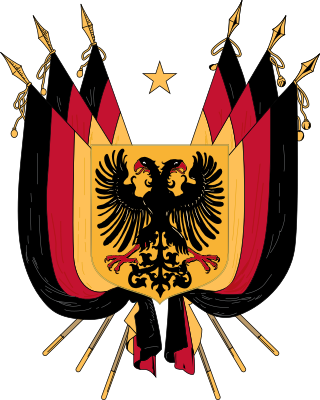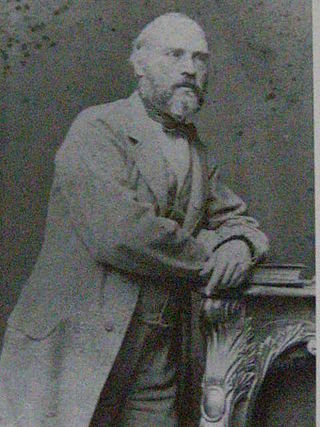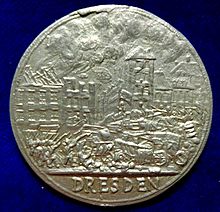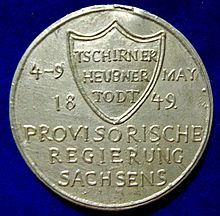
Frederick Augustus II was King of Saxony and a member of the House of Wettin.

Saxony, officially the Free State of Saxony, is a landlocked state of Germany, bordering the states of Brandenburg, Saxony-Anhalt, Thuringia, Bavaria, as well as the countries of Poland and the Czech Republic. Its capital is Dresden, and its largest city is Leipzig. Saxony is the tenth largest of Germany's sixteen states, with an area of 18,413 square kilometres (7,109 sq mi), and the sixth most populous, with more than 4 million inhabitants.

The German Confederation was an association of 39 predominantly German-speaking sovereign states in Central Europe. It was created by the Congress of Vienna in 1815 as a replacement of the former Holy Roman Empire, which had been dissolved in 1806.

Frederick William IV, the eldest son and successor of Frederick William III of Prussia, was king of Prussia from 7 June 1840 until his death on 2 January 1861. Also referred to as the "romanticist on the throne", he was deeply religious and believed that he ruled by divine right. He feared revolutions, and his ideal state was one governed by the Christian estates of the realm rather than a constitutional monarchy.

The Revolutions of 1848 in the Austrian Empire were a set of revolutions that took place in the Austrian Empire from March 1848 to November 1849. Much of the revolutionary activity had a nationalist character: the Empire, ruled from Vienna, included ethnic Germans, Hungarians, Poles, Bohemians (Czechs), Ruthenians (Ukrainians), Slovenes, Slovaks, Romanians, Croats, Italians, and Serbs; all of whom attempted in the course of the revolution to either achieve autonomy, independence, or even hegemony over other nationalities. The nationalist picture was further complicated by the simultaneous events in the German states, which moved toward greater German national unity.

The German revolutions of 1848–1849, the opening phase of which was also called the March Revolution, were initially part of the Revolutions of 1848 that broke out in many European countries. They were a series of loosely coordinated protests and rebellions in the states of the German Confederation, including the Austrian Empire. The revolutions, which stressed pan-Germanism, demonstrated popular discontent with the traditional, largely autocratic political structure of the thirty-nine independent states of the Confederation that inherited the German territory of the former Holy Roman Empire after its dismantlement as a result of the Napoleonic Wars. This process began in the mid-1840s.

The French Second Republic, officially the French Republic, was the second republican government of France. It existed from 1848 until its dissolution in 1852.

The Frankfurt Parliament was the first freely elected parliament for all German states, including the German-populated areas of the Austrian Empire, elected on 1 May 1848.

The Kingdom of Saxony, lasting from 1806 to 1918, was an independent member of a number of historical confederacies in Napoleonic through post-Napoleonic Germany. The kingdom was formed from the Electorate of Saxony. From 1871, it was part of the German Empire. It became a free state in the era of Weimar Republic in 1918 after the end of World War I and the abdication of King Frederick Augustus III of Saxony. Its capital was the city of Dresden, and its modern successor state is the Free State of Saxony.

Gustav Anton Zeuner was a German physicist, engineer and epistemologist, considered the founder of technical thermodynamics and of the Dresden School of Thermodynamics.

The revolutions of 1848, known in some countries as the Springtime of the Peoples or the Springtime of Nations, were a series of revolutions throughout Europe over the course of more than one year, from 1848 to 1849. It remains the most widespread revolutionary wave in European history to date.
The Baden Revolution of 1848/1849 was a regional uprising in the Grand Duchy of Baden which was part of the revolutionary unrest that gripped almost all of Central Europe at that time.

Carl August Röckel was a German composer and conductor. He was a friend of Richard Wagner and active in the German revolutions of 1848–1849.

The Palatine uprising was a rebellion that took place in May and June 1849 in the Rhenish Palatinate, then an exclave territory of the Kingdom of Bavaria. Related to uprisings across the Rhine river in Baden, it was part of the widespread Imperial Constitution Campaign (Reichsverfassungskampagne). Revolutionaries worked to defend the Constitution as well as to secede from the Kingdom of Bavaria.
The Battle of Rinnthal was the heaviest battle of the Palatine uprising and took place on 17 June 1849 near Rinnthal in the Annweiler valley in Europe. The revolutionary troops under August Willich tried in vain to halt the advance of Prussian troops on Landau.

The Battle of Kirchheimbolanden was the first battle in the Palatine Uprising of 1849. It took place on 14 June near Kirchheimbolanden and ended in the defeat of the volunteers (Freischaren) by the Prussian Army.

The Battle of Ludwigshafen and the subsequent bombardment of Ludwigshafen lasted from 15 to 18 June 1849 and was part of the Palatine Uprising and Baden Revolution. The young settlement of Ludwigshafen was badly damaged by the shells of the Baden artillery and the resulting fires.

The Imperial Constitution campaign was an initiative driven by radical democratic politicians in Germany in the mid-19th century that developed into the civil warlike fighting in several German states known also as the May Uprisings (Maiaufstände). These conflicts against the counter-revolutionaries began in May 1849 and varied in length and intensity depending on the region. Some lasted until July that year. They marked the end phase of the popular and nationalist March Revolution that had started in March 1848.

Saxony in the German Revolution (1918–1919) followed a path that went from early control by workers' and soldiers' councils to the adoption of a republican constitution in a series of events that roughly mirrored those at the national level in Berlin. Because some members of the revolutionary councils, which were set up in major cities such as Dresden, Leipzig and Chemnitz, wanted a soviet-style council government while others favored a parliamentary republic, there was considerable internal disagreement that caused a split between the two groups. In early February 1919, elections were held for a state assembly, the Volkskammer, in which the moderates gained control. An outbreak of violence at the time of the March 1919 Kapp Putsch led the national government to forcibly remove the Leipzig workers' council, the last one remaining in the state. Saxony went on to become a constituent state within the Weimar Republic in November 1920.
Events from the year 1849 in Germany.




















